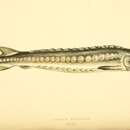Diagnostic Description
provided by Fishbase
Body elongated, pentagonal section (Ref. 51442). Snout moderate with tip narrow and pointed (Ref. 3397), mouth inferior (Ref. 59043). Lower lip not continuous, interrupted at center (Ref. 3397). Four barbels halfway between snout tip and mouth but not reaching the latter (Ref. 3397, Ref. 51442). No scales, but 5 rows of scutes on the body: dorsal 9-16, lateral 24-39 on each side, ventral 9-14 on each side, with dense cross-lines of smaller rhombic plates between the dorsal and lateral rows (Ref. 2196, Ref. 3397, Ref. 40476, Ref. 51442). Dorsal side greenish-brown to blackish with golden tints, flanks light with silvery tints, belly white (Ref. 3397).
Life Cycle
provided by Fishbase
Anadromous species, with adults migrating to the middle reaches of large rivers mainly in spring and early summer. Spawning occurs between March and August, when water temperature rises above 20 °C at depths of 2-10 m over stony bottoms in areas with strong current (1.5-2.0 m/s) (Ref. 51442, 59043, 89103).Mature individuals do not feed during spawning migration (Ref. 3193). Number of spawned eggs increases with age. After spawning adults return to the sea (Ref. 51442). The development of the sticky dark grey eggs (2.6-3.0 mm diameter) takes about one week at 17°C (Ref. 26160, 35388). It is suggested that males spawn every 2 years, females every 3-4 years (Ref. 89072). Upstream spawning migrations appear to be positively correlated with water levels in rivers and distances of 1,000 kilometres or more may be covered when water levels are high (Ref. 89104). Sturgeons in general have a high capacity for hybridization and most species are able to cross-breed (Ref. 89103, 89117). This species has been reported to cross-breed (albeit rarely) with the Danube sturgeon (Acipenser gueldenstaedti) (Ref. 89105).
Migration
provided by Fishbase
Anadromous. Fish that ascend rivers to spawn, as salmon and hilsa do. Sub-division of diadromous. Migrations should be cyclical and predictable and cover more than 100 km.
Morphology
provided by Fishbase
Dorsal spines (total): 0; Dorsal soft rays (total): 30 - 44; Analspines: 0; Analsoft rays: 23 - 30
Trophic Strategy
provided by Fishbase
Solitary at present because rare (Ref. 231). Feeding ceases during migration and spawning (Ref. 89072). Adults feed on benthic invertebrates and fish (Ref. 231, 51442), larvae and juveniles feed on small crustaceans and insect larvae (Ref. 51442, 89072).
Biology
provided by Fishbase
Amphihaline and anadromous fish (Ref. 51346, 51439), frequenting littoral zones (Ref. 2163, 51439, 51442). A long-lived and slow-growing species (Ref. 9988). It lives the major part of his life in sea but enters rivers for reproduction (Ref. 30578, 51442). Found on various substrates, from sand to rocks (Ref. 51346). At the sea, it occurs in coastal and estuarine zones. In freshwaters, it inhabits estuaries and large rivers (Ref. 59043). Juveniles found both in estuaries and in the sea (Ref. 2163), they slowly adapt to saltwater (Ref. 89103) and usually spend around 2-3 years in river estuaries before moving to the sea (Ref. 40152), some may migrate to the sea during their first summer (Ref. 59043). Usually solitary. Feeds on crustaceans, mollusks, polychaete worms and small fish. Today most males only reach 100-150 cm length, females 130-215 cm (Ref. 59043, 89104). Utilized fresh and frozen, and also for caviar; eaten steamed, pan-fried, broiled, boiled, microwaved and baked (Ref. 9988). A threatened species, mainly due to bycatch, poaching, habitat degradation (spawning grounds, nursery areas) and physical obstacles to migration (Ref. 26160).
Importance
provided by Fishbase
fisheries: commercial; aquaculture: commercial

